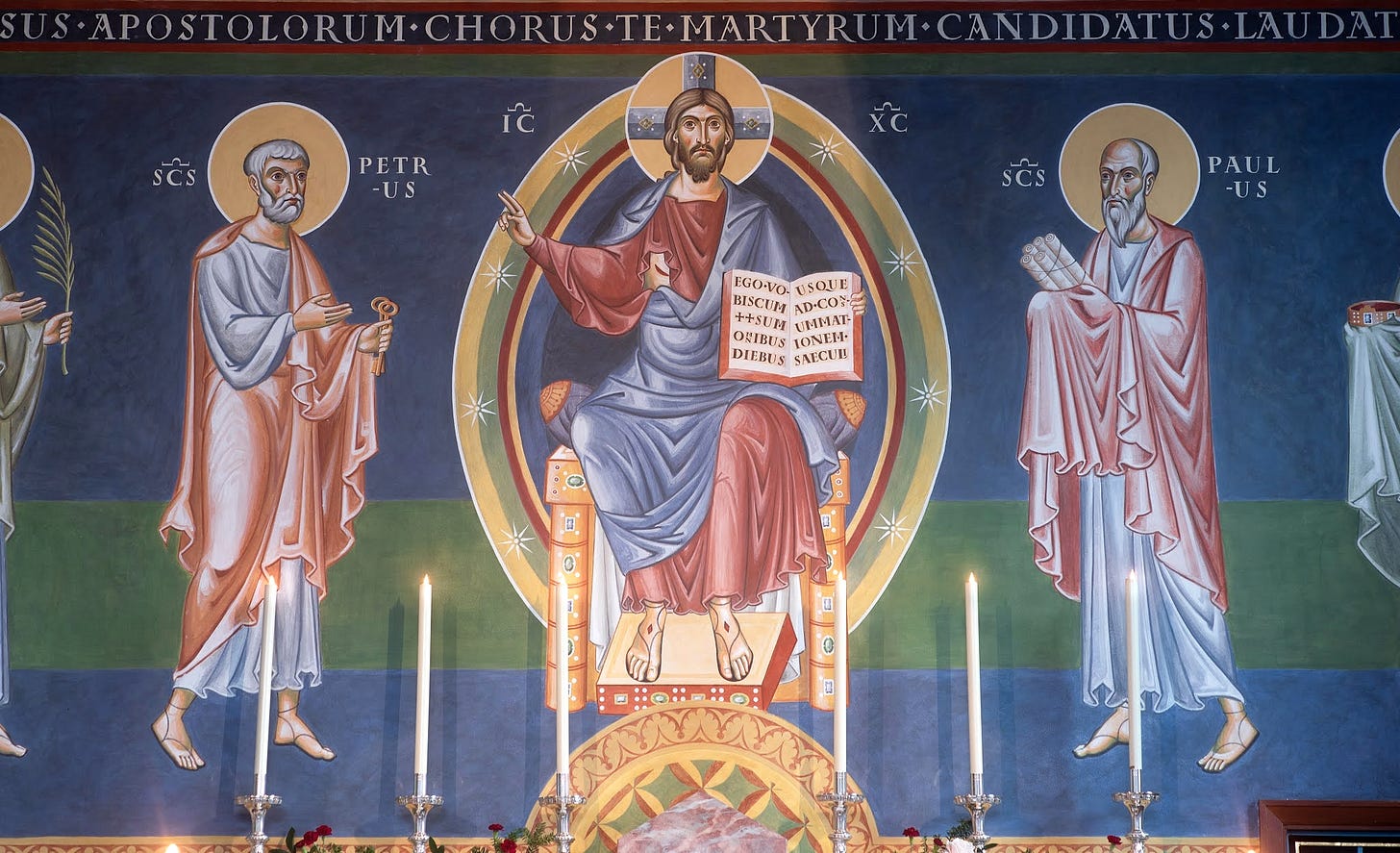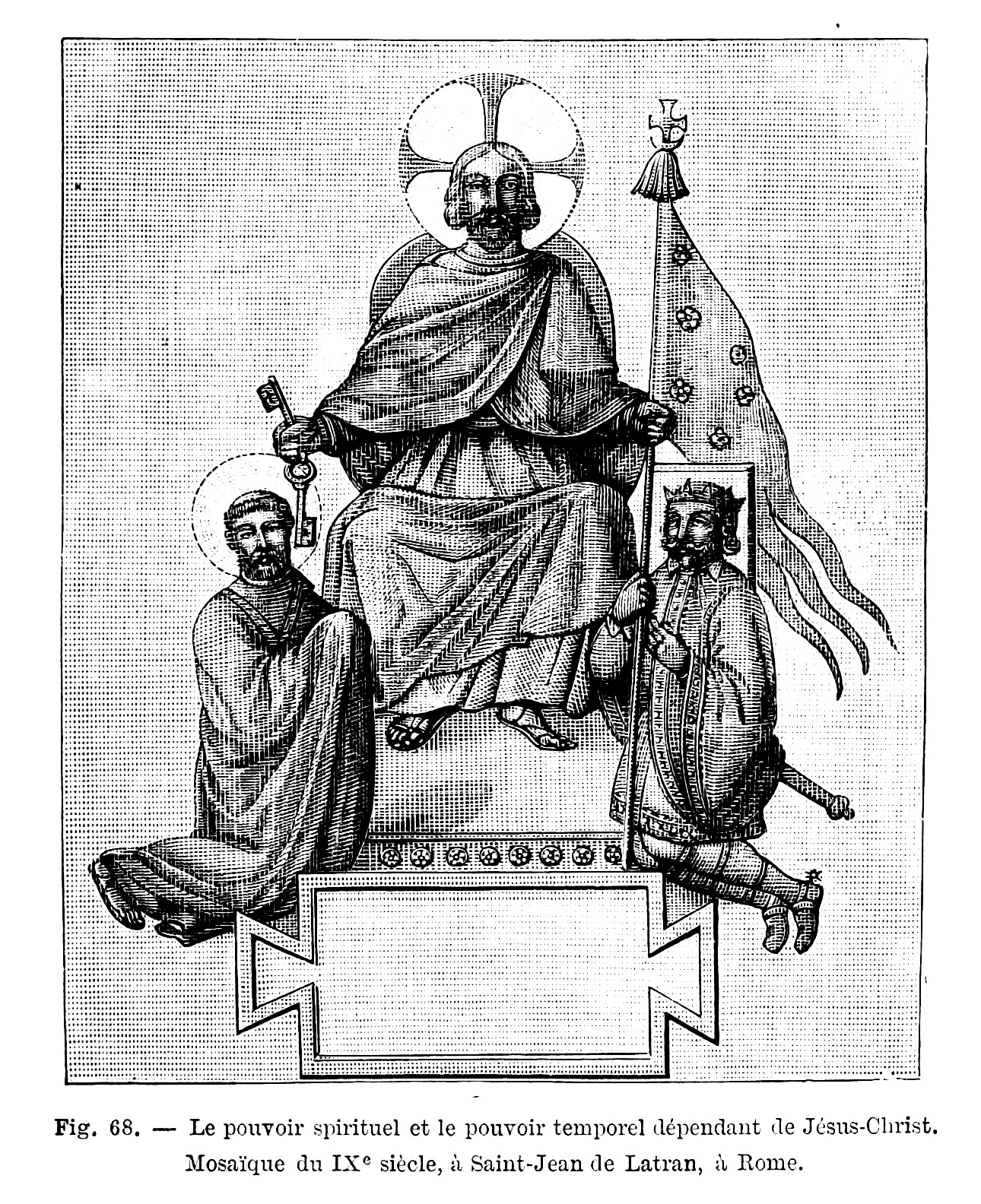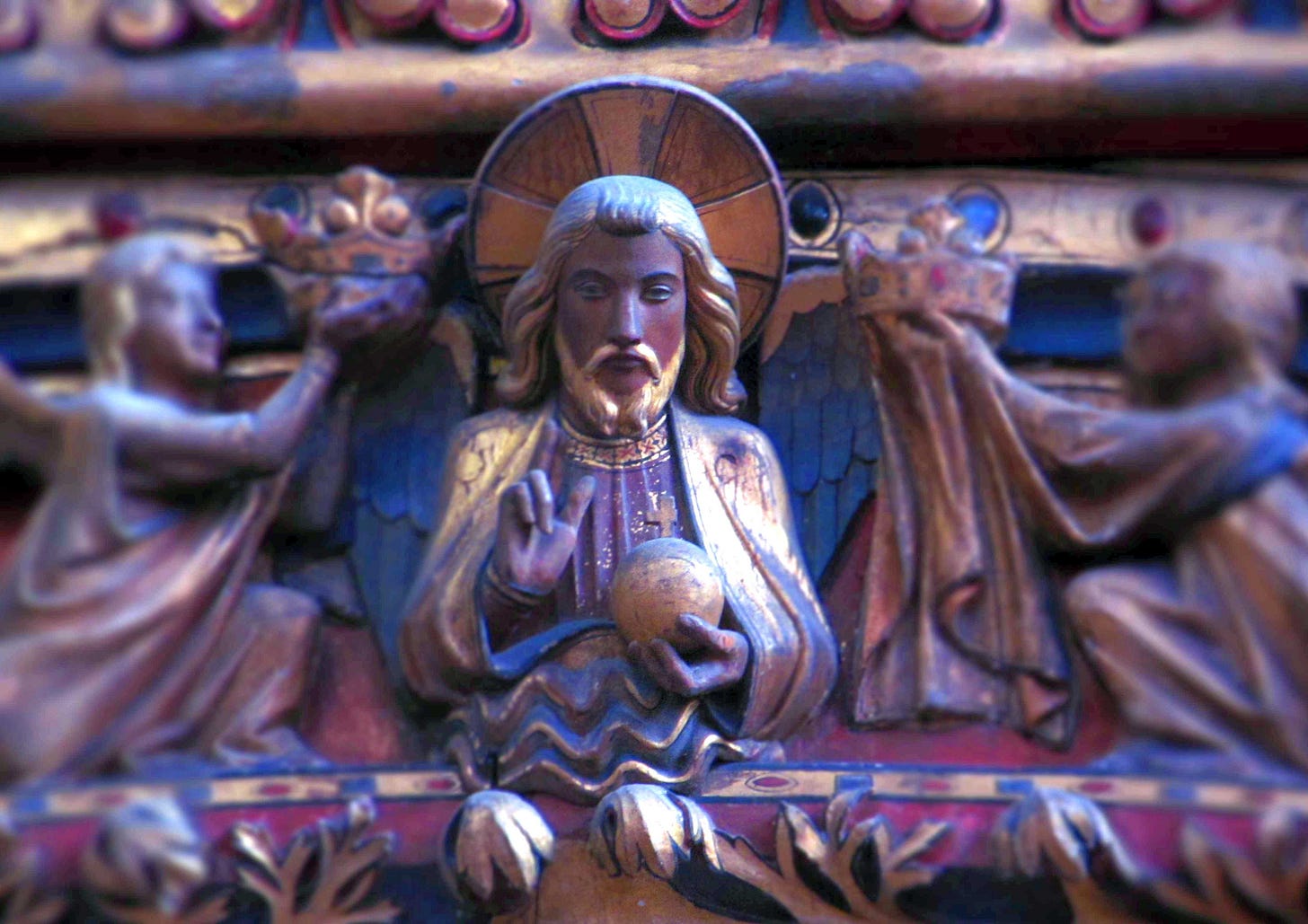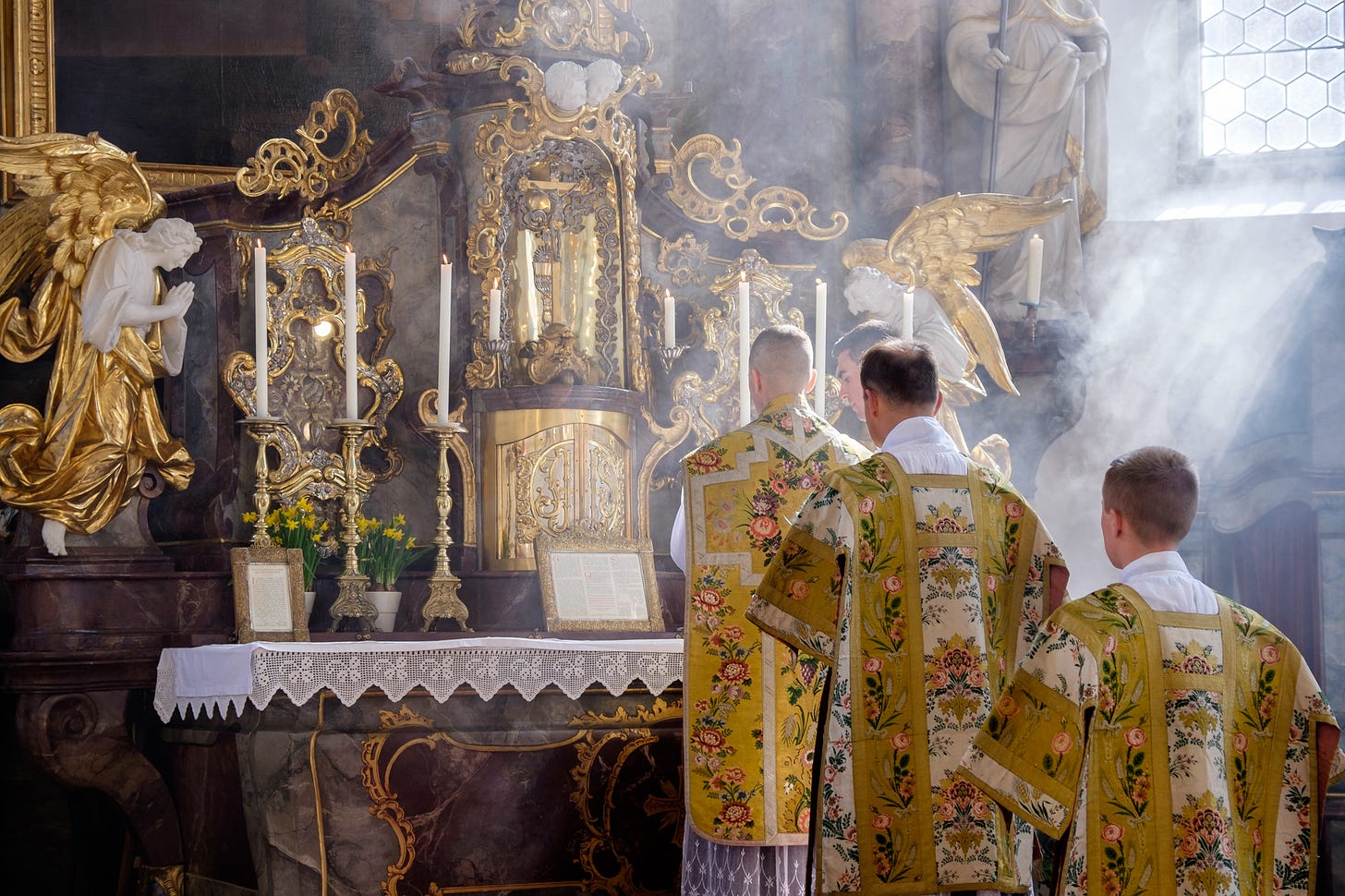Two Dates, Two Different Feasts: October vs. November “Christ the Kings”
There’s a LOT more going on than a simple bump to the end of the year

NOTE. Annual subscribers should by now have received a voucher that can be applied to a subscription at Pelican+. Please check your spam folder in case it landed there. If you didn’t receive one, or if you have any other questions about the transition from Substack to Pelican, please send me an email, or write to team@piouspelican.com. Everyone else may simply use this link to obtain a discount on a subscription.—Dr. K
With the revival of the traditional Roman Mass throughout the Church, a number of rather significant differences between the old and new calendars become obvious to the faithful and call for explanation.
One of the most notable differences between the two calendars is the location of the Feast of the Kingship of Our Lord Jesus Christ. In the old calendar, it is always celebrated on the last Sunday of the month of October, right before All Saints. In the new calendar, a feast often called “Christ the King” is situated as the last Sunday of the liturgical year, one week before the start of Advent. In practice, the gap between the old and new Christ the Kings is about one month.
In a recent circular email to his parishioners — part of a multi-pronged apologia for abandoning the TLM and “unifying” around the Novus Ordo as per his bishop’s (narrow) application of Traditionis Custodes — the rector of the basilica of SS. Peter and Paul in Chattanooga, Very Rev. J. David Carter, very deliberately commented on this discrepancy:
Our Unity of Faith movement will begin at the Feast of Christ the King in the new calendar, November 23, 2025. This feast was a recent addition to the calendar in 1925, when it was placed on the last Sunday of October. The Church has since determined that it is more fitting at the end of the liturgical year to celebrate when Christ will come in His glory to reign. The Church’s discernment in moving the feast is not evil nor bad. In fact, we can see great good in this. Its original placement on the last Sunday of October was somewhat arbitrary. The last Sunday of the liturgical year has more purpose. We can see wisdom in the new way.
Is Fr. Carter right to say that the original placement was “somewhat arbitrary” and that the new location “is more fitting,” “has more purpose,” and exhibits “wisdom”? By the end of today’s article, we will have discovered the answer.
Seeking the origins
To understand why the feast was originally instituted on the last Sunday of October, let’s take a look at the reasons given by Pope Pius XI himself for choosing it:
By Our Apostolic Authority We institute the Feast of the Kingship of Our Lord Jesus Christ to be observed yearly throughout the whole world on the last Sunday of the month of October—the Sunday, that is, which immediately precedes the Feast of All Saints.… Most fitting of all for this purpose is the last Sunday of October, on which the course of the liturgical year is nearly closed [quo fere cursus anni liturgici clauditur],1 and thus the feast of the Kingship of Christ sets the crowning glory upon the mysteries of the life of Christ already commemorated during the year, and, before celebrating the triumph of all the Saints, we proclaim and extol the glory of Him who triumphs in all the Saints and in all the Elect. Make it your duty and your task, Venerable Brethren, to see that sermons are preached to the people in every parish to teach them the meaning and the importance of this feast, that they may so order their lives as to be [lives] worthy of faithful and obedient subjects of the divine King. (Encyclical Letter Quas Primas, 28–29)
Pius XI’s intention, as can be gleaned from the entire encyclical (you can read a summary here, featuring the most telling quotations), is to emphasize the glory of Christ as inaugurated by His earthly mission, visible and perpetuated in history by the saints. Hence, the feast falls shortly before the Feast of All Saints, to emphasize that what Christ inaugurated in His own person before ascending in glory, the saints then instantiate and carry further in human society, culture, and nations. It is a feast primarily about celebrating Christ’s ongoing kingship over all reality, including this present world, where the Church must fight for the recognition of His rights, the actual extension of His dominion to all domains, individual and social.
Pius XI’s intention in instituting the feast was to insist on the rights of Jesus Christ here and now, and the corresponding duties of men and nations on earth. To quote the encyclical again:
The empire of our Redeemer embraces all men. To use the words of Our immortal predecessor, Pope Leo XIII: “His empire includes not only Catholic nations, not only baptized persons who, though of right belonging to the Church, have been led astray by error, or have been cut off from her by schism, but also all those who are outside the Christian faith; so that truly the whole of mankind is subject to the power of Jesus Christ.” Nor is there any difference in this matter between the individual and the family or the State; for all men, whether collectively or individually, are under the dominion of Christ. In Him is the salvation of the individual, in Him is the salvation of society…. If, therefore, the rulers of nations wish to preserve their authority, to promote and increase the prosperity of their countries, they will not neglect the public duty of reverence and obedience to the rule of Christ…. When once men recognize, both in private and in public life, that Christ is King, society will at last receive the great blessings of real liberty, well-ordered discipline, peace and harmony. (Quas Primas 18–19)
In addition, although unmentioned in Quas Primas, everyone was aware, especially in Europe, that the last Sunday in October had been celebrated for centuries as “Reformation Sunday,” commemorating the defiance of Martin Luther.2 A Catholic counter-feast reminding the world not only of the comprehensive Kingship of Jesus Christ (so often denied socially and culturally by various teachings of Protestantism) but also of the worldwide kingly authority of His Church would certainly be a reasonable application of the principle lex orandi, lex credendi!
It’s also worth noting, as further evidence against Fr. Carter’s claims, that the old calendar already celebrated “when Christ will come in His glory to reign”—namely, on the last Sunday of the liturgical year, the Twenty-Fourth Sunday After Pentecost, when the Gospel is about the end of the world. In fact, the ancient Roman rite doubly underlines the coming of Christ in glory by also devoting the Gospel of the first Sunday of Advent to the same theme. It is all part of the way the old rite emphasizes the royal splendor of Christ’s reign in time and in eternity, surrounded by His court of angels and saints in heaven, and faithful worshipers on earth. (You can read more about these things in my articles “Heaven and Earth Shall Pass Away“ and “Enter His Courts With Praise: Liturgical Reverence for Christ the King.”)
Out with the old, in with the new
In the mid- to late 1960s, a tidal wave of changes in Catholic worship came rolling through the Church, with a last tsunami starting in Advent of 1969 with the rollout of the Novus Ordo. Among the changes it introduced was the relocation of the feast of Christ the King from the last Sunday of October to the last Sunday of the liturgical year, at the end of November. Yet as Michael Foley shows in his important article “A Reflection on the Fate of the Feast of Christ the King,” the feast was not merely moved; it was transmogrified. It was given a new name and new content that deemphasized the social reign of Christ and put in its place a “cosmic and eschatological Christ” (in the words of liturgical reformer Pierre Jounel).
As Foley details:
According to no less an authority than Pope Paul VI, the Feast of Christ the King was not merely changed or moved; it was replaced. In Calendarium Romanum, the document announcing and explaining the new calendar, the Pope writes: “The Solemnity of Our Lord Jesus Christ King of the Universe occurs on the last Sunday of the liturgical year in place of the feast instituted by Pope Pius XI in 1925 and assigned to the last Sunday of October....” The key word is loco, which means “in place of” or “instead of.” The Pope could have simply stated that the Feast occurs on a different date (as he did with the Feast of the Holy Family) or that it is being moved (transfertur) as he did with Corpus Christi, but he did not. The Novus Ordo’s Solemnity of Christ the King, he writes, is the replacement of Pius XI’s feast.
This replacement feast was put on the last Sunday of the Church year so that one week later would fall the first Sunday of Advent, a position emphasizing the eschatological dimension of Christ’s kingship: the Kingdom of Jesus Christ, though begun in time, is here present “as in a mystery” (as Lumen Gentium phrases it) and in a “crucified” way. This Kingdom will be perfected and fully manifested only at the end of time, with the Second Coming. Hence in the new calendar the observance comes at the very end of the Church’s year, as the summation of the whole of salvation history and the symbol of what we hope for: “as we await the blessed hope and the coming of our Savior, Jesus Christ,” as the Novus Ordo’s revised embolism says.
Pius XI’s clear and unambiguous proclamation of Christ’s kingship over the world here and now certainly does not sound like Vatican II’s Dignitatis Humanae or the postconciliar diplomacy of the Church. It is hard to resist thinking that the eschatological perspective betrays weak knees before the challenge of modern secularization, as well as hesitation about a perceived “triumphalism” of traditional Catholic social teaching.
In other words, the kingship of Christ is palatable and proclaimable so long as its realization comes at the end of time, and does not impinge too much on the political and social order right now—or on the Church’s responsibility to convert the nations, invigorate their cultures, and transform their laws by the light of the Faith. The removal to the last Sunday of the liturgical year gives the observance an “end of the world” twist, as if to say: the Kingdom of Our Lord does not enter into and permeate history as a leaven, but is postponed to the end of time like a Deus ex machina. The working model is not King St. Louis IX or King St. Stephen of Hungary,3 but Teilhard de Chardin’s Omega Point.
This suspicion is confirmed by an examination of the significant changes made to the liturgy of the day, where direct references to Christ’s kingship over States and rulers have been suppressed, as Michael Davies, Michael Foley, myself, and many other traditionalist authors have noted.4
Paul VI stripped away anything from the Mass or Divine Office of the day that had reference to the conversion of nations and their subjection to the Church. We are not speaking of theocracy but of a correct ordering of Church and state whereby, as Leo XIII teaches, the former stands to the latter as the soul to the body, and, as Pius XII adds, the former illuminates the meaning of the natural law so that the latter may translate it more successfully into civil law. The 1925 version of the Collect of the day (used even till now by traditionalists) conveys the traditional doctrine:
Almighty everlasting God, who in Thy beloved Son, King of all men, hast willed to restore all things; mercifully grant that all the families of nations, rent asunder by the wound of sin, may be placed under His most pleasant rule. Who liveth and reigneth…5
The 1969 text substituted for it sharply departs from this integralist vision:
Almighty ever-living God, whose will is to restore all things in your beloved Son, the King of the universe, grant, we pray, that the whole creation, set free from slavery, may render your majesty service and ceaselessly proclaim your praise. Through our Lord Jesus Christ, your Son, who lives and reigns…
As Foley details, the contrasts between the other orations—Secret/Prayer over the Offerings and Postcommunion/Prayer after Communion—are no less striking.
Two verses in the hymn for the First Vespers of the feast, Te Saeculorum Principem, were simply removed altogether from Paul VI’s Liturgy of the Hours:
Let the rulers of nations
Extol Thee with public honor;
Let governors and judges worship Thee,
The laws and arts make Thee known.Let kings find renown
In their submission and dedication to Thee;
Bring under Thy gentle rule
Our fatherland and our homes.
Additionally, verse 2’s phrase “the wicked crowd cries out / We don’t want Christ as king” and verse 8’s phrase “Who [viz., Christ] govern the scepters of the world” were replaced with more “politically correct” material. Other significant changes in the Novus Ordo liturgy of the feast all tend in the same direction of the silent denial of Christ’s kingship over nations, peoples, rulers.6

Why did this happen?
The simplest explanation—indeed, the only one that fits the evidence, is that the apparent “integralism” of Pope Pius XI had become an embarrassment to such as Montini, Bugnini, and other progressives of the 1960s and 1970s. They had bought into the philosophy of secularism and wanted to make sure the liturgy did not celebrate the authority of Christ over the socio-political order or the regnant position of His Church within it. The modernized feast has to be about “spiritual” or “cosmic” or “eschatological” things, with a seasoning of “social justice.” As Foley writes: “The new feast guts the original of its intended meaning.… The liturgical innovators kicked the can of Christ’s reign down the road to the end of time so that it will no longer interfere with an easygoing accommodation to secularism.”7 Not for them was the potent teaching of St. Pius X’s encyclical Vehementer Nos:
That the state must be separated from the Church is a thesis absolutely false, a most pernicious error. Based, as it is, on the principle that the state must not recognize any religious cult, it is in the first place guilty of a great injustice to God; for the Creator of man is also the Founder of human societies, and preserves their existence as He preserves our own. We owe Him, therefore, not only a private cult, but a public and social worship to honor Him. Besides, this thesis is an obvious negation of the supernatural order. It limits the action of the state to the pursuit of public prosperity during this life only, which is but the proximate object of political societies; and it occupies itself in no fashion (on the plea that this is foreign to it) with their ultimate object which is man’s eternal happiness after this short life shall have run its course. But as the present order of things is temporary and subordinated to the conquest of man’s supreme and absolute welfare, it follows that the civil power must not only place no obstacle in the way of this conquest, but must aid us in effecting it.… Hence the Roman Pontiffs have never ceased, as circumstances required, to refute and condemn the doctrine of the separation of Church and state.8
The original feast of Christ the King represents the Catholic vision of society as a hierarchy in which lower is subordinated to higher, with the private sphere and the public sphere united in their acknowledgment of the rights of God and of His Church. This vision was put aside in 1969 to make way for a vision in which Christ is a king of my heart and a king of the cosmos—of the most micro level and the most macro level—but not king of anything in between: not king of culture, of society, of industry and trade, of education, of civil government.
In other words, for such middling spheres, “we have no king but Caesar.” The impious cry of the ancient Jews has become our foundational creed. We have bought into the Enlightenment myth of the separation of Church and state, which, as Leo XIII says, “is equivalent to the separation of human legislation from Christian and divine legislation.”9 The result cannot but be catastrophic, as we unmoor ourselves from the very aids God has provided for our human weakness.
What lessons does this shift from Pius XI to Paul VI, from October to November, hold for us?
The very first expression of the Kingship of Christ over man is found in the natural moral law that comes from God Himself; the highest expression of His kingship is the sacred liturgy, where material elements and man’s own heart are offered to God in union with the divine Sacrifice that redeems creation. Today, we are witnessing the auto-demolition of the Church on earth, certainly in the Western nations, as both the faithful and their shepherds run away and hide from the reality of the Kingship of Christ, which places such great demands on our fallen nature and yet promises such immense blessings in time and eternity. The relentless questioning of basic moral doctrine (especially in the area of marriage and family), the continual watering down of theology and asceticism, the devastation of the liturgy itself—all these are so many rejections of the authority of God and of His Christ.
There is urgent need for the Church on earth to hail Christ once again as her King, and as the ruler of all men—with the mightiest, including all rulers of the earth, and the pope himself, being the most subject to Him. For let us make no mistake about it: even if Dignitatis Humanae was intended to be a teaching about the modern secular state, it quickly became, by a kind of reflex effect, a teaching about the modernized and secularized Church. It was the Church, now, that could no longer confess Christ unambiguously as the one and only Savior of mankind; it was the Church that was not permitted to go forth to convert Jews, Muslims, Protestants, or pagans; it was the Church that needed to bend the knee, not before the King of kings, but before presidents and parliaments, before international organizations and environmentalist summits. The Covid debacle cleared away any lingering doubts that the effect, whether intended or not, of the social dethronement of Christ was His spiritual dethronement in the Church.
The original Pius XI feast of Christ the King, still observed wherever the authentic Roman Rite has been preserved, proclaims the full truth of Catholic Social Teaching, while the retooled feast that replaced it in the Modern Rite of Paul VI subverts that full truth. As with the benighted liturgical reform in general, so with this deconstructed feast in particular: the postconciliar changes sought a modus vivendi with a modern West that was already tottering on the edge of its final rebellion against all order, divine and human. It can be no surprise that vitality will be found in the Catholic Church today above all where the traditional rites of divine worship have been retained or recovered; nor is it surprising that the original feast of Christ the King, placed at the end of October just before the feast of All Saints, has become the titular feast (as it were) of the cultural and political Reconquista now in its infancy.
The foregoing was largely adapted from my new book: His Reign Shall Have No End: Catholic Social Teaching for the Lionhearted (XIII Books, 2025).
The Vatican translation of this document omits to translate the Latin word “fere,” which means “almost, about, nearly.” Thus, Pius XI specifically did not want the feast at the very end of the year, but rather only near it.
It’s exceedingly ironic that Fr. Carter in his various attempts to promote the Novus Ordo over the TLM warns his people against “becoming Protestants,” seemingly unaware of the extent to which the very design of the Novus Ordo was driven by the agenda of ecumenical rapprochement with Protestants and the extent to which it ended up imitating many steps taken by Thomas Cranmer to decatholicize the Anglican liturgy. Nor is it less ironic that the Anglican Ordinariate liturgy has re-incorporated some of the Tridentine elements that Fr. Carter is ready to surrender for the sake of “obedience.” An amazing parody of obedience, allowing enemies of Catholic tradition to tear it from the hearts of the faithful!
See Kwasniewski, “Fiddling with the Collects of Ss Henry II and Louis IX.”
See, for example, pp. 243–51 in Michael Davies’s The Second Vatican Council and Religious Liberty.
Translation by Foley, “Orations of the Feast of Christ the King.” As Foley details, the contrasts between the other orations—Secret/Prayer over the Offerings and Postcommunion/Prayer after Communion—are no less striking.
See Davies for a full account, but also Foley here and here online.
Foley, “A Reflection on the Fate.”
Pius X, Vehementer Nos 3.
Leo XIII, Au Milieu des Sollicitudes 28.





Thanks! This is both timely and clarifying. I've been reading through the two different Christ the King liturgies myself. And it led me to dust off my long-forgotten college textbooks in order to confirm my recollection that the liturgical reform happened during the exact same years when progressive Catholics were also fomenting the collapse of the Portuguese Empire and the spread of Communist insurgencies across Africa. Most people associate Liberation Theology with Latin America in the 1980s. But Angola and Mozambique were both at war during Vatican II. And the Church was under tremendous pressure in both countries. So it's hard not to wonder if the eschatological overtones and the language about "freeing us from slavery" betray the subtle influence of OstPolitik. I would be very curious to hear what you think about this....
I grew up with Christ the king being in November. I did not know it was originally in October until I started going to the TLM. It makes more sense for it to be right before we celebrate All Saints day.